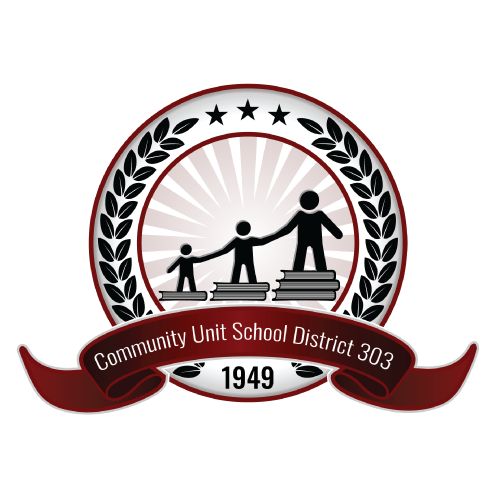Remote Learning Plan Summary
● Student learning that aligns with District 303 curriculum will be delivered through a District supported Learning Management System (LMS) such as Google Classroom, Schoology, Seesaw, or email.
● In an effort to respond to students and their academic needs, staff members will be available between 8:00 am and 3:30 pm.
● Teachers will collaborate with their course and grade-level teams to develop activities and tasks that are aligned with the curriculum and instructional units throughout the duration of remote learning.
● Assessments will be based upon a student’s progression of skills and abilities.
● During remote learning days, District 303 will continue to use the letter grade structure for students in grades 6-12 throughout the remainder of the semester.
● Remote learning days count as student attendance days. On Monday mornings, students in grades 6-12 will receive a brief survey they are expected to complete by noon that records their intended participation in learning for that week and their attendance.

The chart shows the number of suggested minutes students are expected to be engaged in learning each day. The minutes include time with teachers as well as individual work at home. The times do not include elementary specials. English Learner services, special education, and/or related service minutes may be provided outside the suggested time expectations based on individual student need(s).
Asynchronous/Synchronous Learning
Asynchronous/Synchronous Learning
As teachers plan remote learning experiences for students, the delivery method or means by which students will engage with the content or learning can vary. Teachers may plan asynchronous learning or synchronous learning experiences.
Asynchronous Learning:
Students learn content, ask questions, and practice at different times and locations. Examples of asynchronous learning in a remote setting are:
- Pre-recorded presentations, such as slideshows and videos
- Discussion boards
- Social media groups
- Collaborative documents in Google Drive/Schoology, etc.
Synchronous Learning:
Students learn at the same time by attending scheduled meetings are lessons. Examples of synchronous learning in a remote setting are:
- Scheduled time for students to share ideas
- Scheduled video conferences or group phone calls
- Live streamed lectures or demonstrations
The times below are for synchronous learning only, meaning that this schedule only needs to be used when teachers plan for a scheduled learning with the whole class. A is the first day, B it the second day, etc. These scheduled times are only for all group virtual meetings. Schools will inform students ahead of time as to which days are A and B.
Grading 6-12
During remote learning days, District 303 will continue to use the letter grade structure for students in grades 6-12 throughout the remainder of the semester.
- A student's current grade as of March 13 is maintained or improved and does not decrease, provided the student demonstrates continued engagement and ability at a passing level.
- Teachers will continue to advance in the curriculum utilizing both formative and summative grades, but neither can lower a student's grade from March 13.
- Students may earn an "I" (incomplete) or "C" (complete) for assignments not graded to communicate to families, including any work assigned between March 16 and March 27.
- If a student were earning an "F" as of March 13 and has not improved their grade by conclusion of the semester, that student will receive an "I" (incomplete) as a semester grade.
- If a student earns an "I" (incomplete), they will be expected to complete the learning requirements by the end of the first semester upon returning to in-person learning, with the expectations of seniors. Seniors must resolve an "I" (incomplete) to a grade of A, B, C, or D at least five days prior to graduating.
- Our goal is to prepare students for the next level; therefore, teachers will focus on the most essential standards during remote learning.
- For a student to maintain or improve their current grade, they must engage and complete all expected assignments and assessments required by the teacher and demonstrate proficiency of standards.
- Students struggling to maintain or improve their grades may receive additional support from educators within their school.
- Teachers and staff will make every attempt to engage students in remote learning.
Grading Scale
- A: 90-100%
- B: 80-89%
- C: 70-79%
- D: 60-69%
- I*: 59% and below
- * All students earning a 59% and below will receive a grade of Incomplete and be required to demonstrate proficiency of essential standards.

